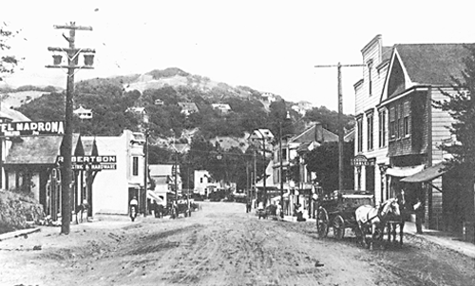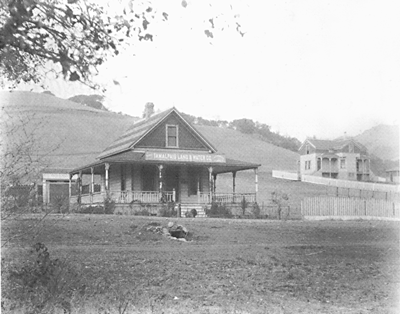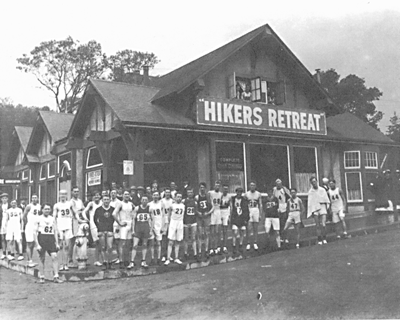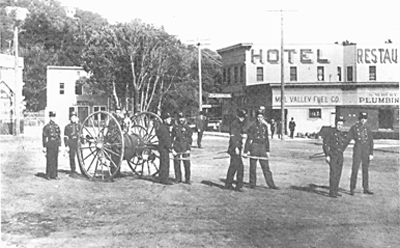
Marin County - Our Towns - Mill Valley
Hosted by permission of Cathy Gowdy of the Marin County Genealogical Society.

Marin County - Our Towns - Mill Valley
Hosted by permission of Cathy Gowdy of the Marin County Genealogical Society.
MILL VALLEY-----------------------------------An early health spaSummer vacationers flocked to this secluded village at the foot of Mount TamalpaisBY MATTHEW STAFFORD |
 |
| By the turn of the last century, Mill Valley had been providing lumber and stellar weekending to the greater Bay Area for 75 years. The region had nurtured Coastal Miwoks since about the signing of the Magna Carta. Five hundred years later, with the incursion of the white man, missions were established, Indians were enslaved and land grants were doled out by the Mexican government to ambitious immigrants with a sparkle to the eyes. | |

Mill Valley Historical SocietyThe Tamalpais Land & Water Company auctioned off subdivided lots in Mill Valley in 1890. The house at right still exists as a yellow Victorian on Lovell Avenue at Bernard. |
Two of them were Irishman John Reed and Englishman
William Richardson. Their grants, which effectively bisect present-day
Mill Valley (Reed's 4,000-acre Rancho Corte Madera del Presidio and Richardson's
19,000-acre Rancho Saucelito), were so poorly delineated, Reed built his
famous sawmill on Cascade Creek in Richardson's territory. No matter: The
mill, built in 1834, was successful enough to establish the future town
as an important lumbering center, and Reed lived happily ever after with
the daughter of the Presidio's commandant.
In 1873, Dr. John Cushing snatched up 360 acres in Blithedale Canyon that were "lost" between these two land grants. A few years later, the establishment of a railroad line through Marin inspired Cushing's heirs to build the Blithedale Hotel. The place was an immediate success, as revelers enjoyed swimming and fishing in the creek, hiking, hunting and riding in the hills and partying galore. Before long, ranches, cottages and other vacation retreats were sprouting on the hills and in the canyons. |
| Meanwhile, a healthy chunk of Richardson's rancho-since deeded to and lost by one Samuel Throckmorton-was subdivided, surveyed and laid out by the newly formed Tamalpais Land & Water Company, headed by a powerful and pervasive shareholder in the Northwestern Pacific Railroad named Joseph Eastland. Eastland ordered a spur line constructed deeper into the valley and hired engineer M.M. O'Shaughnessy of Hetch Hetchy fame to create a new municipality out of the slopes and gulleys of this still-treeless locale (Reed and company had done their job so well, "the redwoods" meant Muir Woods, and only Muir Woods). O'Shaughnessy carefully acknowledged the natural environment with an intricate system of footpaths and connecting staircases, reserving space for churches, schools and parks, and damming Cascade Creek to provide the town with a water supply. | |
| In May of 1890 properties were offered up at a lively auction attended by 3,000 people. Two hundred acres were parceled off, much of it to San Franciscans looking to build their own weekend cottages, and the town of Eastland was born. (It didn't become Mill Valley until the city was officially incorporated in 1900.) The Mill Valley & Mt. Tamalpais Scenic Railway was established in 1896, drawing hundreds of visitors into town each weekend along with those Bay Area hikers who'd been appreciating the beauties of the mountain for decades. (In 1892, 30 donkeys and a guide from the Swiss Alps led a party of adventurers in Tyrolean attire to the summit of Mount Tam.) |  Hiking and running have always been big in Mill Valley.
This establishment, opened in 1911 at Madrona and Throckmorton, offered
hot showers and a place to check your street clothes. Runners await either
the Dipsea or a run up Mt. Tamalpais.
Hiking and running have always been big in Mill Valley.
This establishment, opened in 1911 at Madrona and Throckmorton, offered
hot showers and a place to check your street clothes. Runners await either
the Dipsea or a run up Mt. Tamalpais. |
| With the town's incorporation came a new respectability. The village's lotus-eating ambiance had inspired the establishment of over a dozen saloons, or one for every 50 residents, many of them located in Jagtown, the red light district on the uphill side of East Blithedale Avenue. But by 1901 a group of prohibitionists gained enough power to slow the town's inexorable progress towards that pleasure-loving level of sin exemplified by neighboring Sausalito, and the newly instituted Town Trustees presided over a village of sparse electrical power, unpaved roads, a couple of telephones and an attendant and delightful sense of isolation. | |
|
Mill Valley Historical SocietyIn 1874, Mill Valley was called Eastland, renamed for the president of the North Pacific Coast railway. |
Mill Valley's sleepy, secluded aura was shattered for good when the 1906 earthquake rocked San Francisco to its foundations and weekend commuters fled the city to take up residence in their vacation cottages. The physical damage sustained by the town was "hardly worth mentioning," the "Mill Valley Record" reported in an April 27 story that shared front page space with a lengthy list of quake refugees setting up camp in the shadow of Mt. Tam. The several hundred names itemized on that front page formed the basis for Mill Valley's rapid growth over the next few months, as the city population count jumped to 1,000 permanent and 1,000 summer residents. |
| With all this new taxpaying citizenry on the premises, Mill Valley enjoyed an enviable flurry of urban improvement. The trustees got their very own town hall. A high school was built out on the mudflats of Miller Avenue so Southern Marin teenagers wouldn't have to make the long train ride up to San Rafael. A bigger, better water source-Mt. Tam's Fern Canyon-provided the town with mountain-fresh H2O. The town outgrew its brand-new telephone plant in two years and had to build another one. A "boulevard through Tennessee Valley from Manzanita station to the ocean" was in the planning stages. And the "Record" reported that "the entire heart of town, from the old water company office to the Bank building on Throckmorton avenue, and down Miller avenue to Landgraff's bridge, will be paved with Barber asphalt." | |
| All of this civic pride was occurring in a county not far in time or temperament from its Wild West roots. The same week that the site for a new town library was purchased, a Sausalito school trustee killed himself with strychnine, the town marshal of Larkspur faced undisclosed felony charges, Kentfield saloons were rowdy enough to face permanent closure, the Alto train crossing was described (for cause) as a "death-trap" and, as San Rafael High's Principal Drew began the year's graduation exercises, "hisses and catcalls drowned his first words, and these were followed by more substantial insults in the shape of overripe tomatoes and a small cabbage or two." The "Record", meanwhile, reported on a suffrage card party at the Outdoor Art Club, a horse-and-buggy accident downtown, a panther attack on Mt. Tam and the particulars of how "a sturdy blacksmith punished a gang of rowdies" who "have made a practice of insulting women in the vicinity of the NWP depot." |
 |
| With that, the town settled into two decades of slow, steady growth. The Dipsea Race and the Mountain Play evolved into cherished institutions. Future movie icon Erich von Stroheim, fresh off the boat from Germany, settled here a while, and another great-to-be, Eve Arden, was Tam High's homecoming queen of 1928. The great fire of 1929 destroyed two hundred Summit Ridge homes as well as the already-near-death mountain railway, another lovely victim of the automobile. And the Locust Avenue shopping area, the first commercial district outside downtown, was developed later that same year. | |
|
Charles Ford CollectionIn 1908, Tamalpais Union High School was built atop the mudflats of lower Miller Avenue. |
The 1937 opening of the Golden Gate Bridge gave Mill Valley its greatest shake-up since the earthquake, as Highway 101 was realigned to take advantage of this new coastal link between north and south. A bridge was constructed over Richardson Bay to replace what had been Highway One (which ran through Tam Junction and down Camino Alto to Corte Madera over the old railroad grade) as Mill Valley's principal intercity artery. The town's unprecedented accessibility led to greater automobile traffic, tourism and settlement. Real estate became Mill Valley's big business, and marshes were filled and the course of Corte Madera Creek was altered to make way for the building boom. Within three years, railroad service into Mill Valley was discontinued. The Sausalito shipbuilding frenzy of World War II (and the subsequent baby boom) brought in many a new settler as well. |
| During the postwar years, Jack Finney published "Invasion of the Body Snatchers", in which emotionless aliens take over Santa Mira (a thinly disguised Mill Valley); Jack Kerouac lived in a shack just up Almonte Avenue from the 2AM Club; Ernest Hemingways' granddaughters, Margaux and Mariel, were among the city's more sweet-faced young residents; Duke Ellington and Pete Seeger played the Mountain Theater during one month of 1966; and a lovely new city library opened amongst the redwoods of Cascade Canyon. | |
| John Goddard turned Village Music
into an international mecca for everyone from Cab Calloway to Elvis Costello;
Jeanie Patterson did likewise with the star-packed stage of the Sweetwater
nightclub; Doris Day played a Mill Valley career woman on her self-titled
sitcom; the city council unanimously approved a resolution calling for
the immediate withdrawal of American troops from Vietnam, making Mill Valley
the first community in America to do so; Rita Abrams recorded her hit song,
"Mill Valley"; the NBC documentary "I Want it All Now" called Mill Valley
"the cocaine capital of America"; the Mill Valley Film Festival began and
eventually flourished; and Huey Lewis and the News released their megahit
album, "Sports", featuring a cool cover shot of the News getting tanked
at the 2AM Club.
Still, obviously, a good place to pass a weekend. |
 |